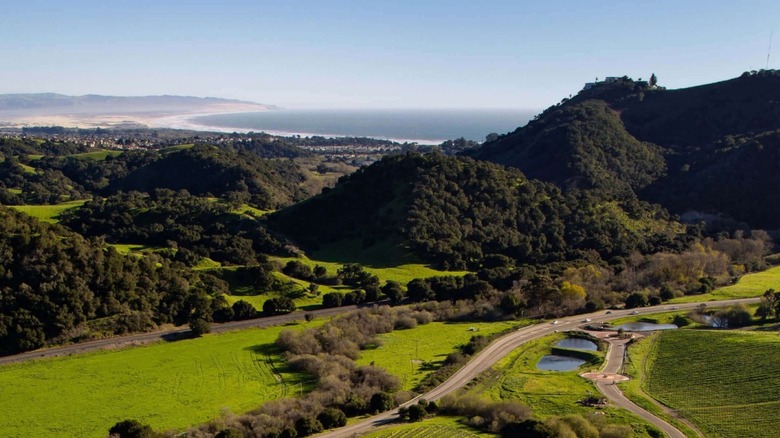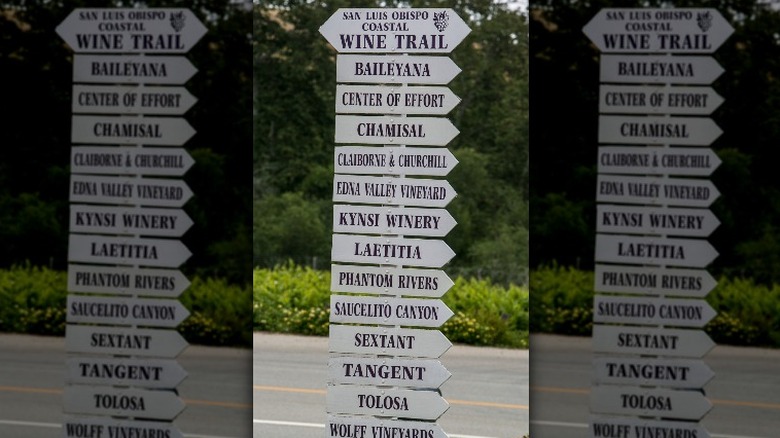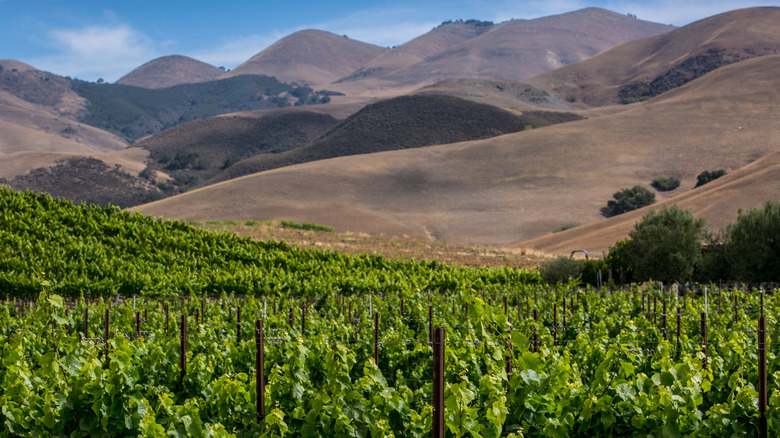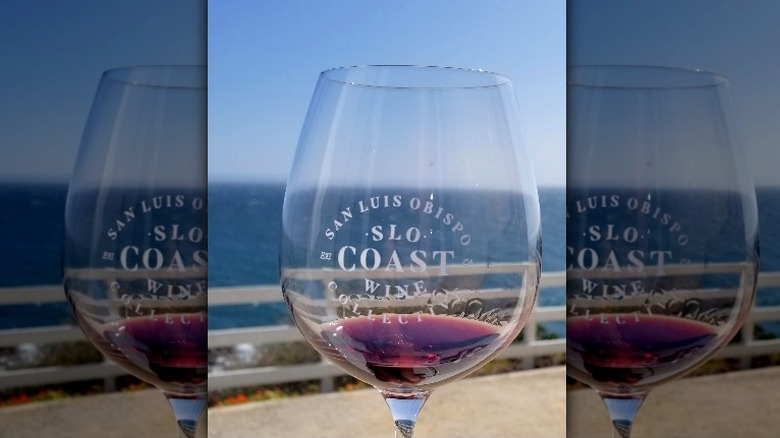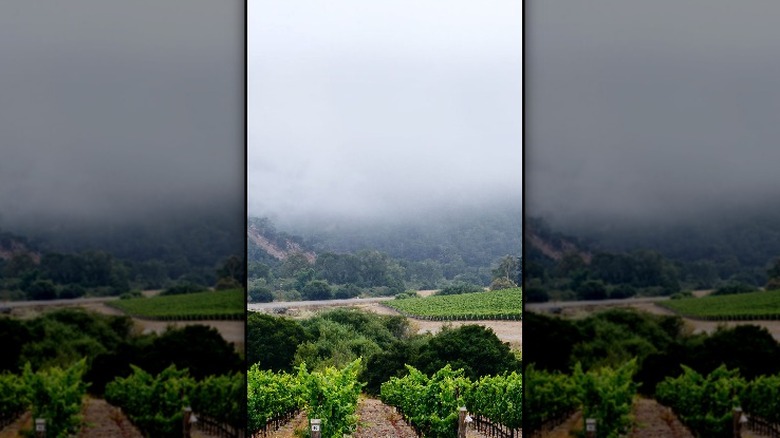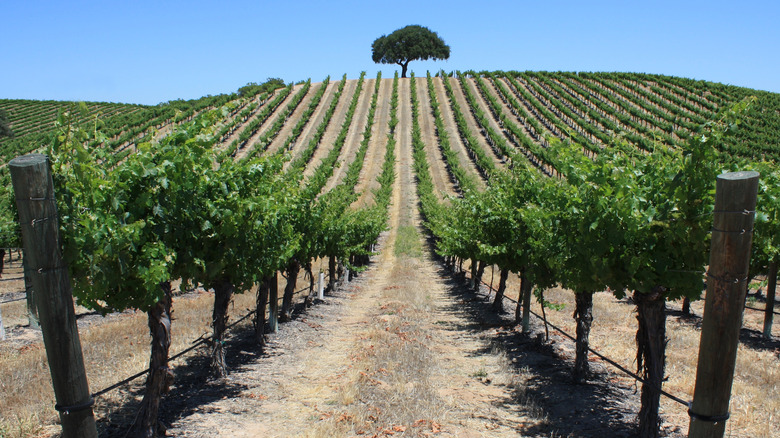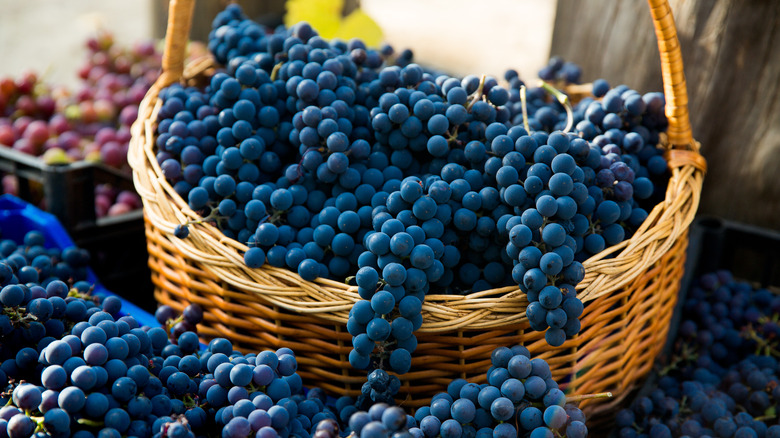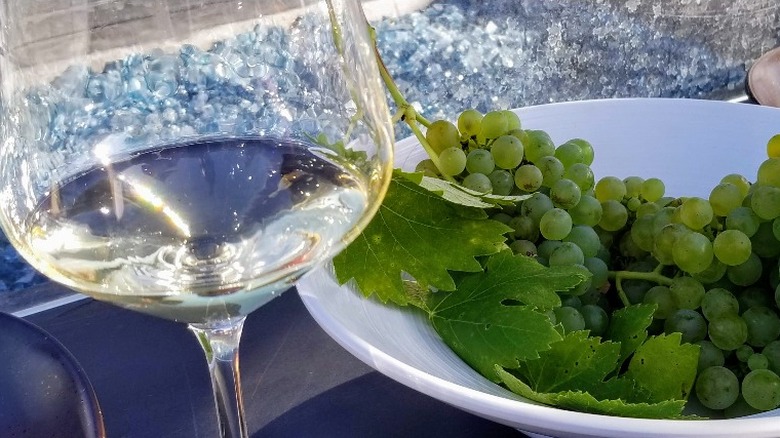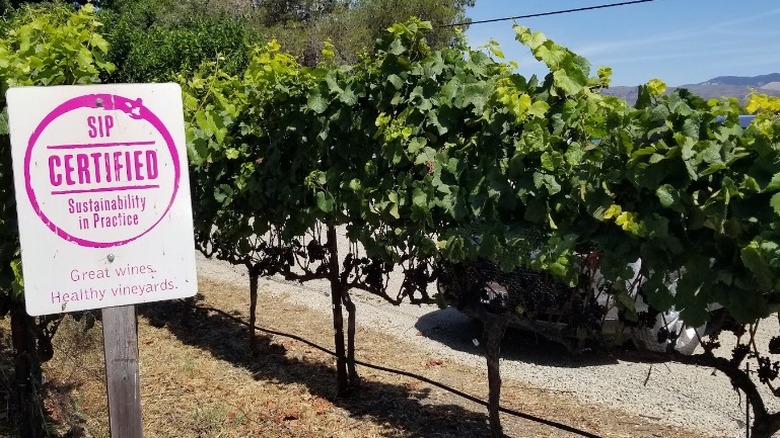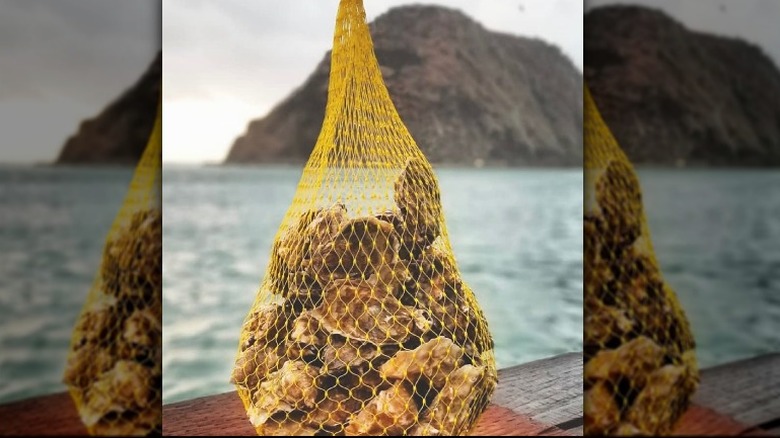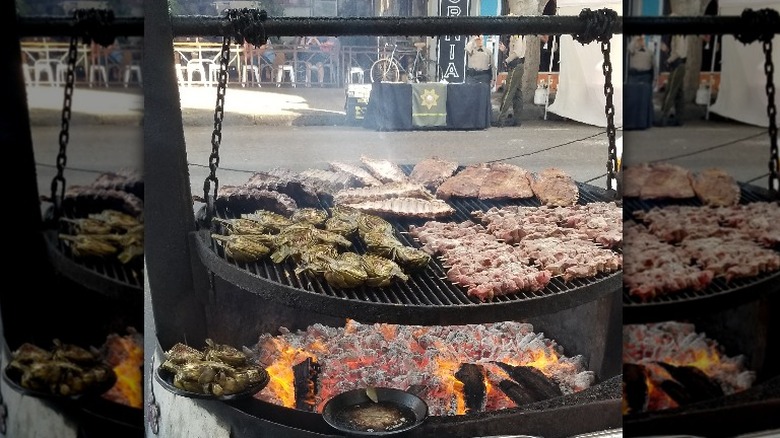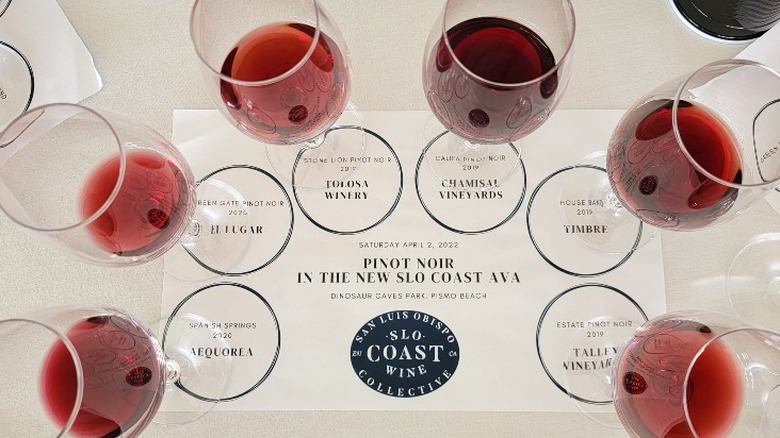Everything You Need To Know About SLO Coast Wine
We love wine. From refreshing and light to juicy and rich, enjoying wine has become a standard part of dinner pairings and happy hour gatherings. Americans consumed 1.1 billion gallons of wine last year. The economic value of the wine industry was $63.69 billion in 2021, with the majority of consumers drinking table wine, i.e., a glass of chardonnay or merlot, with their evening meal (via Grand View Research). California contributes heavily to the industry, producing over 80% of the country's wine. Yet, for a long time, California's wine regions were less distinct than you may think — at least, technically.
The latest region to become an American Viticultural Area (or AVA) in California is San Luis Obispo Coast, or SLO Coast, receiving approval in March 2022. This emerging region may be the hidden gem of California wine, but we don't think it will be for long. Thanks to the coastal location and diverse soil types, the SLO Coast is one of California's most interesting regions. The 60-mile stretch is centrally located between Los Angeles and San Francisco.
Unique and exceptionally rare, visitors can fly into the airport and five minutes later visit a vineyard, hit the surf, or fish for halibut and salmon. Sitting right off the Pacific Ocean, the area has been producing aromatic, highly invigorating white and red wines for decades. These are highly fragrant wines with energy and vibrancy, refreshingly acidic and delivering pristine taste, each as incredible as those who make them.
SLO Coast is hitting its stride
The first winemaking Vitis vinifera vines were planted in the area over 250 years ago, per Wine History Project. But the recent story of wine SLO Coast started about 50 years ago. Tasting Table spoke with John H. Niven, Brand Ambassador for SLO Coast winery Baileyana, who shared with us that SLO Coast has long been a farming community.
Niven comes from a family of SLO Coast winemaking pioneers. He says, "In the early 1970s, area chickpeas and dairy farmers began planting vineyards with cool-climate varieties." His grandparents, Jack and Catharine Niven, were among the first vintners in Edna Valley, planting 13 different grape varieties in their 500+ acre Paragon Vineyard in 1973. Today three of those varieties are still producing lively, aromatic wines.
Niven's grandmother planted three acres of chardonnay in front of their family home, starting Baileyana Winery in the 1980s. She was the first female in the region to do so. Niven's grandfather, Jack, wrote the petition for Edna Valley to become an AVA in 1982. Over the following years, additional farmers and ranchers began planting vines throughout the area, establishing the Arroyo Grande Valley AVA to the south of Edna Valley (via San Luis Obispo Guide).
Eight years ago, Aaron Jackson of Cambria's Aequorea Wines filed a petition with the Alcohol and Tobacco Tax and Trade Bureau (TTB) on behalf of the 32 member wineries of the SLO Coast Wine Collective, requesting the 408,585-acre area become an AVA (via Wine Enthusiast).
SLO Coast wraps Edna and Arroyo Grande Valleys
Within the newly established SLO Coast AVA lie two regions, Edna Valley and Arroyo Grande Valley. Edna Valley is known for quality chardonnay fruit, thanks to the maritime climate (via Wine History Project). The environmental influence on the fruit brings high acidity, which translates to freshness in the wines, even when the fruit is fully ripe.
Arroyo Grande is in the southern part of the region. The valley is veiled by a layer of fog most of the day, particularly in parts of the AVA closest to the ocean, which keeps temperatures mild and steady.
Though Arroyo Grande and Edna Valley are significant, they don't include the entire area where grapes are growing, like in northern Cambria. Previously, light-bodied Cambria wines could not differentiate their unique location. Labels could only note Cambrian wine under the umbrella of being from California or Central Coast — areas often associated with large-scale wine production. Or, as Wine-Searcher describes, labels would indiscriminately say that the wine hailed from San Luis Obispo County, which includes the robust red wine region of Paso Robles.
By including the entire area stretching from northern San Simeon to southern Nipomo, all vineyards and wineries are recognized, including those sitting outside the previously designated AVAs. John Niven shared that some new wineries will now fall under the official SLO Coast AVA umbrella. More importantly, many of the area's boutique growers, who sell fruit to producers throughout the state, can now directly market grapes as SLO Coast AVA designated fruit, defining its quality.
What is in the name SLO Coast?
After waiting eight years for approval, does the name matter to consumers? Winemakers and vintners hope it does.
The TTB defines an AVA for American wine "as a delimited grape-growing region having distinguishing features, a name, and a delineated boundary. These designations allow vintners and consumers to attribute a given quality, reputation, or other characteristics of a wine made from grapes grown in an area to the wine's geographic origin. The establishment of AVAs allows vintners to describe more accurately the origin of their wines to consumers and helps consumers to identify wines they may purchase."
Kathleen Naughton, Executive Director of The SLO Coast Wine Collective, recently spoke with Tasting Table about the development of this new AVA. She says, "The establishment of the San Luis Obispo Coast AVA provides a benchmark for consumers to understand what to expect in that bottle of wine."
Including San Luis Obispo Coast or SLO Coast on a wine label identifies a unique location, which producers hope consumers will notice when drinking the wine, giving them something to search out again. Establishing the AVA, which includes more than 50 wineries and 78 commercial vineyards on nearly 4,000 planted acres, will equip consumers to recognize the wines they buy.
Naughton adds, "There is much to offer in such a small space. The designation will give the region the notoriety it deserves."
SLO Coast has refrigerated sunshine
Wine regions often hang their hats on a pivotal characteristic to define their wine. In SLO Coast, the most important is the extreme proximity to the Pacific Ocean. Per SLO Coast, all vineyards are within five miles of the ocean. According to Kathleen Naughton, "SLO Coast is the coolest growing region in California with the closest proximity to the coast, producing one of the world's longest growing seasons."
As the AVA petition noted, 97% of the region's climate is maritime. Daytime temperatures rarely exceed 78 degrees F. Evenings welcome a layer of Pacific fog, with temperatures consistently dropping to around 50 degrees F.
Grapes enjoy slow maturation, holding vibrant acidity while achieving full ripeness, even with early-ripening varieties. Normally, chardonnay, pinot noir, and sauvignon blanc are California's first-picked fruit. Not in SLO Coast.
Tasting Table spoke about recent harvests with Rob Takigawa, Director of Winemaking for Baileyana, Tangent, Zocker, and True Myths. He says, "Chardonnay enjoys an extremely long hang-time before harvest, creating richness with freshness. It is often picked after all red grape varieties. And, sauvignon blanc didn't occur until November last year." For comparison, Napa Valley's 2021 harvest was completed by mid-October (via the Napa Valley Register).
As heat spikes become more prevalent, global warming is a concern for Takigawa. But as a whole, SLO Coast temperatures remain mild throughout the season. He says, "The Pacific dictates the wine; thankfully, fog and wind keep everything fresh."
It is all about the soil in SLO Coast
The wind and the fog are vital components to creating wines with light and energy, but the soils make these wines unique. In this viticultural region, the Santa Lucia Mountains and the Pacific Ocean flank terraced hillsides and low-lying valleys. These hills and valleys contain a mix of dozens of different soil types. Vineyards near the beach and ocean have well-draining sandy loam soils filled with fossils and marine sediments. The foothills around the Santa Lucia Mountains contain sandstone, shale, and metamorphosed sedimentary rocks. In the mix of these is a line of volcanic morros called the Nine Sisters, formed over 20 million years ago, adding to the area's diversity (via Outdoor Revival).
Volcanic soils bring complexity with mineral intensity, creating earthy, spicy, floral notes in wines. Limestone and marine sedimentary soils give complexity to wines with mineral intensity. These characteristics are similar to other limestone-rich regions growing similar varieties, including Burgundy, Loire, and Rhone Valley. The variance of soil types, often from acre to acre, creates interesting, layered wines with structure, texture, and concentration, as noted by Wine Tasting San Luis Obispo.
SLO Coast and Burgundy have much in common
Burgundy's hillsides and rocky valleys, which are lined with limestone soil, create wines with complexity and character. Similarly, pinot noir and chardonnay flourish in SLO, just as in these grape's native region of Burgundy, France.
When John Niven's grandparents planted their 13 varieties, the thought was to see what could do well in the area. Three types thrived, including chardonnay and pinot noir. Vinous shares how growing these Bourgogne varietals in SLO Coast creates premium wines; The SLO vinos are comparable to selections from the region's northern and southern neighbors, Santa Lucia Highlands and Sta. Rita Hills, yet completely unique with elegance and definitive style wrapped in energy.
Baileyana makes several passes through the sandy loam, volcanic, and marine sedimentary soil-filled vineyard to pick the fruit for Firepeak Chardonnay, which is made without malolactic fermentation to highlight the natural freshness the region gives the fruit. The resulting wine has texture, balance, and refinement, with citrus, golden pear, and melon accompanying fresh tarragon and mint.
The leading varieties in the area will likely always be chardonnay and pinot, which account for over 75% of the grapes grown here. Still, the region crafts a slew of other aromatic types of white wines, like riesling and gewürztraminer, and Rhone varietal red wines. Vineyards in the inland foothills of the Santa Lucia Mountain grow zinfandel, creating structured cool-climate wine. Today, 20 total varieties are growing in SLO Coast — plenty more than in Burgundy.
This white wine is a SLO Coast game-changer
Stimulating, aromatic white wines are a significant focus for the region. The variety that John Niven is most excited about is albariño. SLO Coast has so many similarities to the variety's home of Galicia, Spain, that its potential in the region is undeniable.
One of the trademarks of Galician albariño, predominantly coming from the terraced hillsides of the Rias Baixas region within Green Spain and bordering the Atlantic Ocean, is a briny salinity (via Wine-Searcher). Breezes blow off the ocean, leaving a salty mist in the air throughout the region, a similar seafaring climate to that of SLO Coast.
Producers in warmer parts of California state work with the albariño grape variety to produce wines with tropical fruit and fresh floral notes. However, the zesty, mineral-driven freshness with the salinity that SLO Coast brings is unique to the area.
The Nivens family first became interested in the variety after creating Tangent Wines in the mid-2000s. Niven says, "Of all the lesser-known white wines, I think albariño has jumped out of the pack to become a top option for white wine lovers." Tangent albariño shows tropical guava, mandarin, crushed stone, and tangy saltiness without using oak in fermentation or aging, allowing the purity of the fruit to shine. Stephen Ross albariño, an SLO wine from the Spanish Springs Vineyard (right next to the ocean), gives flinty, mineral-intensity to its vintage, meddling equatorial and stone fruit flavors with spicy citrus.
SIP in SLO Coast
There is a laid-back feeling in the air on SLO Coast. Per Kathleen Naughten, "The people of San Luis Obispo Coast are down to earth. This region was founded by bootstrappers, families, visionaries, and craftsmen. The inclusive culture of the SLO Coast wine region is very evident." The way of life is about slo(w) living. The pace is calm, the people are friendly, and the environment is healthy.
Winemakers leave work early to surf with fellow vintners. They raise their kids and take care of each other and the earth. They produce wines to showcase the gifts of Mother Nature with a low intervention approach.
With this, many SLO Coast wineries focus on being stewards of the environment. Naughten adds, "The farming culture on the Central Coast instills long-term respect for the earth. The majority of vineyard acreage in the SLO Coast is Sustainability in Practice Certified."
Sustainability in Practice (SIP) Certification focuses on the people, the planet, financial prosperity, with quality of life. Wineries pay competitive wages, care for the natural habitat, and work ethically, focusing on environmental health.
Tolosa Winery Director of Digital Communications, Jonathan Rios, shared the winery's view on sustainability with Tasting Table. He said," We value sustainably in several ways. It's not just in farming practices, but also in how we place importance on the health of our loved ones, the relationships within our organization and the surrounding community, and the economic security of our employees."
Look to the ocean to pair SLO Coast white wines
From Pismo and Avila Beach to Morro Bay and Cambria, the local seafood is abundant and delicious, perfect for a classic wine and food pairing with bone-dry, saline-infused, energetic whites from the area.
The Los Angeles Times reports that over 100 years ago, Pismo Beach was clam central. Though clam production throughout the area's beaches dried up a few dozen years ago, chowder remains a local favorite. While climate change continues to affect the U.S. food supply, surf and deep sea fishing still provide salmon, halibut, lobster, yellow-fin tuna, steelhead, rainbow trout, and seabass to areas within the SLO region. Without a fishing license, you can even fish directly off Pismo Beach Pier or Avila Pier.
Edible San Luis Obispo shares the Pacific Gold oyster thrives in the cold ocean waters surrounding the volcanic Morro Rock at the entrance to Morro Bay. Morro Bay Oyster Company harvests 750,000 plump, juicy bivalves yearly, perfect to grill or fry with our oyster po'boy recipe.
Head south to pair with SLO Coast red wines
For pairing with earthy pinot noir, smokey syrah, or black fruit-filled zinfandel, head just south of SLO Coast for the meat-loving staple dish of the region, Santa Maria barbecue. An important style of American barbecue, this regional technique is a staple throughout Central Coast that dates back to when early area ranchers grilled steaks over open pits filled with red oak (via Santa Maria Valley).
In the 1950s, a Santa Maria butcher began using trip-tip as the customary meat, creating the dish as it is known today. Before this time, the cut from the sirloin tip was considered one of the best cuts of beef to slow-cook, stew, or turn to ground beef. Fortunately, butchers knew that it could be an affordable cut of meat for grilling to juicy, tender, sustaining perfection.
Santa Maria-style Pitmaster Jamie Flores shares that this barbecue is best done when grilled over red oak on adjustable grills, allowing you to raise or lower the grates and modify the temperature while cooking the meat quickly. The adjustable Santa Maria Grill has also become a staple for regional barbecue grilling. Bonus, tri-tip is a bit lower in fat than other steaks, perfect for dinners like our tri-tip steak taco recipe. The charcoaled notes go smoothly with the loamy compliments of SLO Coast reds.
SLO Coast wines are affordable
SLO Coast wines are meant to enjoy with food, family, and friends. Though costly SLO Coast options are available, many selections are under $40, and plenty even go under $20 (via Wine-Searcher). For that final price point, Tangent and Zocker Wines sell bottles with screwcaps, which John Niven calls "crack and go" wines that are ideal for backyard barbecuing or watching the sunset by the beach or lake.
The quality and expressive nature of the fruit grown in SLO Coast gives distinction to the wines. They are elegant, approachable, and downright delicious. From ultra-dry reisling from Claibourne & Churchill, to highly aromatic gewürztraminer from Stolo, salty albariño from Croma Vera, plush chardonnay from Baileyana and Oceano, to refined, graceful pinot noir from Talley and Tolosa, these wines should be on your dinner table tonight. As Kathleen Naughton tells us, "It is time to take San Louis Obispo Coast wine seriously." We couldn't agree more.
